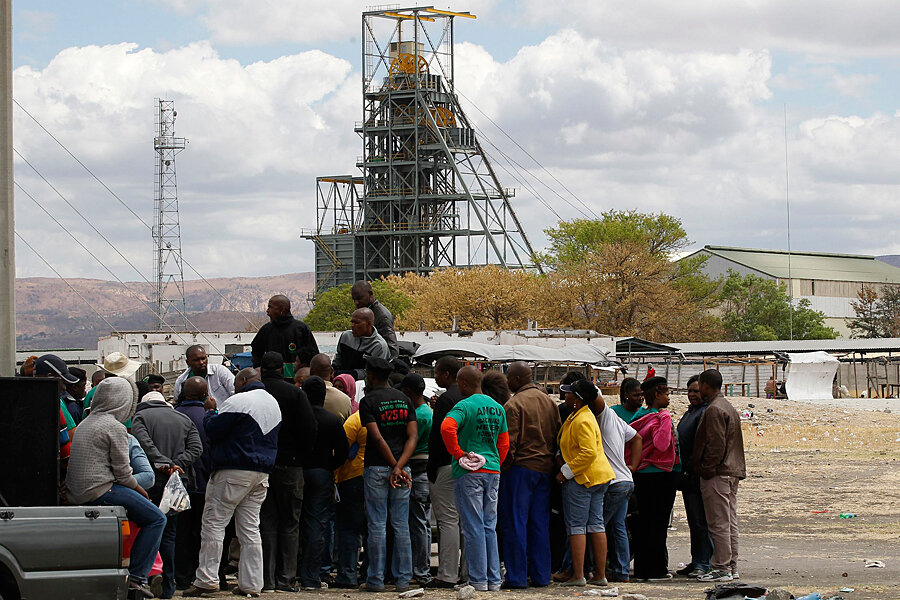Built on gold riches, Johannesburg succumbs to sci-fi sinkholes
Loading...
| JOHANNESBURG, SOUTH AFRICA
The ground shudders and heaves, then slowly rips apart, pulling whatever is nearby — houses, trees, cars, factories — into a newly-formed, gaping hole.
It sounds like a scene from a science fiction film, but over the last several decades, this scenario has played out thousands of times — entirely unscripted — near South Africa’s largest city.
Thanks to a quirk of geography and a lot of human meddling, Johannesburg and its surroundings are pocked with sinkholes. More than a dozen new ones are recorded each year, and since the 1960s, this swath of South Africa has experienced more than 2,000 documented sinkholes. They have been responsible for more than three-dozen deaths and at least $130 million in damages.
Apart from the colossal damage sinkholes have done to local communities and the environment here, they are also a barometer for the broader crises building as Johannesburg struggles to manage the decline of its most historically significant industry: gold mining.
“So many of these mines did not close properly, and so they left behind incredible environmental degradation,” says Mariette Liefferink, CEO of the Federation for a Sustainable Environment. “Taxpayers are now being forced to shoulder the costs, even though it had no share in the pollution.”
Mining legacy
Gold is Johannesburg’s great paradox. The chance discovery here 120 years ago of the precious mineral kick-started the transformation of a bleak stretch of prairie into Africa’s wealthiest city.
But today, after more than a century of mining, most of the readily accessible gold is gone. Many of the major mining houses have either shuttered their South Africa operations or sold them off to the spate of “black empowerment” mining companies that formed in the shadow of the transition to democracy. Most of these groups didn't have the capacity or interest to clean up their predecessors’ environmental messes.
“The entire mining industry was built on a model of limited liability,” says Anthony Turton, an environmental consultant working with mining companies. Historically in South Africa, he says, companies came in, stripped out as much gold as they could, and then quietly retreated, leaving government and civil society to manage the chopped-apart landscape left behind.
The environmental problems from mining are vast and varied. Most visible are the massive sulfur-yellow mine dumps flanking the city, many of which were abandoned and left to blow toxic sediment into the towns and shack settlements pressed up against them.
Meanwhile, across the gold mining belt, deserted mine shafts have filled with groundwater, which mingles with the metal sulfides in the rock, turning it an orange color and rendering it potently acidic. Rising up through the shafts, this so-called acid mine drainage (AMD) spills into rivers, streams, and groundwater, poisoning drinking water and threatening the Cradle of Humankind, the UNESCO World Heritage site that is home to some of the oldest known hominin fossils in the world.
Then, of course, there are the sinkholes.
Approximately 25 percent of Gauteng — the province where Johannesburg is located — sits on dolomitic rock. It’s highly susceptible to erosion when groundwater levels change suddenly, says Tharina Oosthuizen, an engineering geologist at the South African Council for Geoscience, which monitors sinkhole risk.
“It’s about poor water management,” Ms. Oosthuizen says. “98 percent of our sinkholes are human made.”
'A small catastrophe'
Historically, mines extracted massive quantities of groundwater to dig their shafts, triggering the ground around the structures to collapse suddenly. In one area west of Johannesburg, near the town of Venterspos, mining has set off more than 1,000 sinkholes since the 1960s.
Occasionally, a single sinkhole is incredible enough to gain widespread notoriety. For instance, in the middle of the night on Aug. 3, 1964, a massive sinkhole swallowed a house in the mining village of Blyvooruitzicht, 50 miles west of Johannesburg. Six people were sleeping inside the home, and the hole was so deep that no trace of the family was ever recovered.
In most cases, however, sinkholes are simply a small catastrophe for the surrounding area, which often can’t afford the intrusion. About 110 shack communities — known in South Africa as “informal settlements” — sit on sinkhole-prone dolomite in Gauteng province.
Any time the groundwater levels change suddenly — not only from mining but also from leaking pipes, heavy rain, or poor water management — these areas are at risk of sudden collapse, Oosthuizen says.
That makes controlling sinkholes an issue of human rights, says Ms. Liefferink.
“As mining declines we can expect to keep seeing an increase in sinkholes,” Liefferink says. “And the greatest cost of these disasters will continue to be carried by the poor. It’s the most unfair thing you could imagine.”






